Chassis Refurb Options
Discussion
Hi All,
The chassis on my Chimaera is looking decidedly tired. I'm considering stripping it down to the bare chassis myself, and then sending it off to somewhere to save on labour costs of them removing the body. Has anyone gone down this route before? If so, how much did it cost and who did you use? I'm located in the midlands.
Thanks
The chassis on my Chimaera is looking decidedly tired. I'm considering stripping it down to the bare chassis myself, and then sending it off to somewhere to save on labour costs of them removing the body. Has anyone gone down this route before? If so, how much did it cost and who did you use? I'm located in the midlands.
Thanks
Google is your friend. Lots of threads across these TVR forums about chassis refurbs and options.
Striping down to the chassis and rebuilding a TVR isn't that difficult on the 'mechanic' scale but there are some hard bits - wheel bearing bolts for example.
There really is excellent value in searching through the TVR forums, as a whole, on here. Chassis treatments are not model dependent and info isn't always cross posted between the subsets.
Striping down to the chassis and rebuilding a TVR isn't that difficult on the 'mechanic' scale but there are some hard bits - wheel bearing bolts for example.
There really is excellent value in searching through the TVR forums, as a whole, on here. Chassis treatments are not model dependent and info isn't always cross posted between the subsets.
Hi,
I'm in Scotland so can't help on Places etc.
If you have enough room you can do most of the work yourself.
This guy got the prep done to remove the body in 4 to 5 hours... I took 18 Days :-)
https://www.youtube.com/watch?v=iX8OLAhvehQ
Once the body is off, it's a case of removing the Engine/Gearbox/Diff/Brakes etc.
Again all doable if you are confident to remove a body.
Here is a link to the Guide I used
https://tvrcarclub.de/wp-content/uploads/2016/12/TVRChimaeraBodyLiftChecklist22Nov09v1.pdf
Then if you've gone that far you can face the pain of taking the bushes out, or that might be the point to palm it off :-)
And of course, as you take things apart expect to pay for new bits... it'll go up & up :-)
Good Luck
Mark
I'm in Scotland so can't help on Places etc.
If you have enough room you can do most of the work yourself.
This guy got the prep done to remove the body in 4 to 5 hours... I took 18 Days :-)
https://www.youtube.com/watch?v=iX8OLAhvehQ
Once the body is off, it's a case of removing the Engine/Gearbox/Diff/Brakes etc.
Again all doable if you are confident to remove a body.
Here is a link to the Guide I used
https://tvrcarclub.de/wp-content/uploads/2016/12/TVRChimaeraBodyLiftChecklist22Nov09v1.pdf
Then if you've gone that far you can face the pain of taking the bushes out, or that might be the point to palm it off :-)
And of course, as you take things apart expect to pay for new bits... it'll go up & up :-)
Good Luck
Mark
You may as well get it blasted and paint it yourself, some useful stuff in this thread regarding paint.
https://www.pistonheads.com/gassing/topic.asp?h=0&...
https://www.pistonheads.com/gassing/topic.asp?h=0&...
There are a couple of very good Chim threads - check out ChimpOnGas https://www.pistonheads.com/gassing/topic.asp?h=0&... and Classic Chim https://www.pistonheads.com/gassing/topic.asp?h=0&...
They are long reads but worth it. I also stripped my TVR S down and rebuilt in early 2000's when I refurbed the chassis, having it blasted then I repaired and painted with Hammerite and then again last year (I changed my engine and 'box to a Jaguar) this gave me a chance to check out the chassis - there was no rust at all so recoated with Hammerite again.
They are long reads but worth it. I also stripped my TVR S down and rebuilt in early 2000's when I refurbed the chassis, having it blasted then I repaired and painted with Hammerite and then again last year (I changed my engine and 'box to a Jaguar) this gave me a chance to check out the chassis - there was no rust at all so recoated with Hammerite again.
My best advice would be to avoid powder coat, powder coat is popular for the following reasons:
1. It's cheap, because all you need is a shipping container as your booth and basic oven, and a few hundred quids worth of kit, check out the cost of setting up a professional paint booth and compare it with powder coating set up costs and you'll soon see why it's so popular
2. It gives a lovely smooth finish that makes for some fantastic looking results, especially in our favorite PH chassis restoration posts
3. Unlike a wet paint system the operator doesn't need any special skills to apply it, very professional looking results can be achieved by someone with very little to no training, and in what in the world of proper wet painting would be considered an extremely dirty environment
But for all it's advantages, which are really only advantages for powder coater BTW, the key failing of powder coat is that it doesn't actually bond with the substrate on a molecular level like a properly applied wet paint system will, don't get me wrong some powder coat jobs are incredibly tough but they are completely reliant on this primary film strength. Once chipped, and even the best powder coat job will chip, the writing is on the wall because water will enter under the skin where it'll be trapped, it'll also start to creep as the powder coat begins to lift.
Corrosion of the steel substrate beneath is inevitable, the powder coat will continue to lift because it's not a coating that's chemically bonded to what it's covering (the substrate), powder coat is essentially a heat cured wrap applied electrostatically in powder form, you could galvanize the substrate before powder coating but all you're doing here is solving the weakness of powder coat, ie it's propensity to chip, I'd argue a better approach would be to use a superior coating system in the first place.
It's also worth understanding how galvanizing works, using the anode & cathode principle of dissimilar metals galvanizing is a sacrificial system, ie the zinc or aluminum used will corrode before the steel substrate it's coating. Corrosion is corrosion, do you really want zinc or aluminum oxide forming on your steel chassis under your coating system? If you've galvanized then powder coated a steel chassis when the powder coat chips the galv will start to do it's thing, aluminum or znic oxide will form lifting the powder coat, in this respect its no different to iron oxide.
Galvanizing is a fantastic proven anti-corrosion process that's been used to great effect for 150 years or more, you see it everywhere from Armco crash barriers on the motorway to steel wheel barrows and everything in between. But take note, the theme is nearly always the same, surfaces that get galvanized are not typically painted or powder coated. Don't get me wrong it does go on but the vast majority of galvanized items and structures are just left bare, and they are left bare on purpose to allow the zinc to do it's sacrificial corroding thing.
When choosing your chassis coating system it makes sense to study what products are used in marine industries where extreme saline and impact damage conditions are expected, look at what's used on ship hulls, ferry loading decks where high traffic is expected, and oil rigs. In all cases you'll find two component epoxy based wet paint systems are the coatings of choice, so if you really want your TVR chassis to last it makes sense to follow what the marine and oil industries have been using for years.
The market leaders in marine coatings are International and Jotun, both offer a range of two component epoxy based paint systems that are ideal to protect your TVR chassis for decades. As with powder coat resistance against impact damage is key, however a good epoxy based wet paint system will have self healing qualities powder coat simply can't offer. Better still the development of these paint systems has seen the introduction of plastisers that give flexibility to the coating which massively improves its abrasion and impact resistance.
In summary what you're looking for is an industrial two component epoxy mastic wet paint system, I chose Jotamastic 90 which is the latest and best performing system from Norwegian market leader Jotun, taking it one step further I went with Jotamastic 90 which carries powdered aluminum locked into the paint, this acts as a sacrificial anode, being locked into the paint system itself when it starts to do its thing it's designed not to affect the performance o durability of the coating.
Obviously the performance and longevity of any coating can be directly linked to the quality of surface preparation, however Jotamastic 90 Aluminum is designed to be very forgiving in this respect as it is intended to be used as a maintenance coating as well as the primary coating on new structures. De-rusting is still key but if this is not possible Jotamastic 90 Aluminum will still give outstanding results, properly mechanically de-rust and even if you've missed a tiny area of iron oxide this paint system will itself see to it so it never becomes a growing problem.
As it turns out Jotamastic 90 Aluminum is also a very close match to the silver/grey chassis coating used by TVR on all Chimaeras and Griffiths up to the end of 1996, this fortunate twist of fate worked in my favor as I have one of the last Chimaeras built with the superior protected silver/grey chassis that is well accepted to last a lot longer than the dreaded while powder coated chassis' that followed. Jotamastic 90 Aluminum can be put onto service within just 48 hours or less depending on the grade of activator used, however the full molecular cure will take a full three months after which there isn't a wet pain system in the world that can tough it for durability, longevity and corrosion resistance.
My chassis and wishbones received two coats of Jotamastic 90 Aluminum and ended up taking some 5 litres of paint in total at a cost of £101.28 all in inculing VAT & delivery.
More on this paint system and the results on the final page here:
https://www.pistonheads.com/gassing/topic.asp?h=0&...
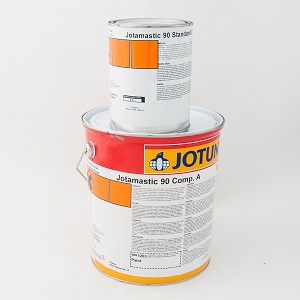
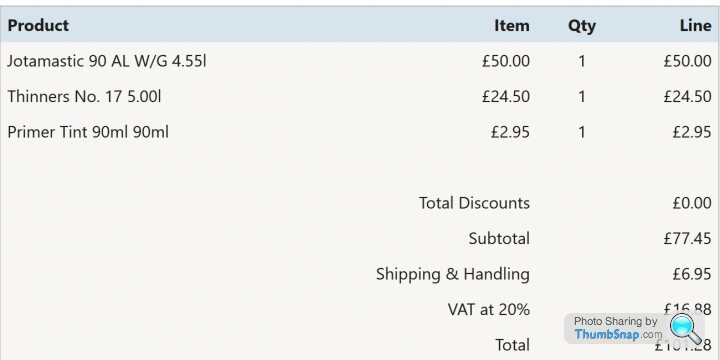
And this is what it looks like on my chassis applied by brush, don't dismiss brush paining either as you can actually achieve a higher film thickness with a brush and this is how Jotun intend for their Jotamastic 90 Aluminum to be applied, it can also be sprayed out but will require additional thinning which can have a slight negative impact on its performance long term so in many respects 'brush is better'
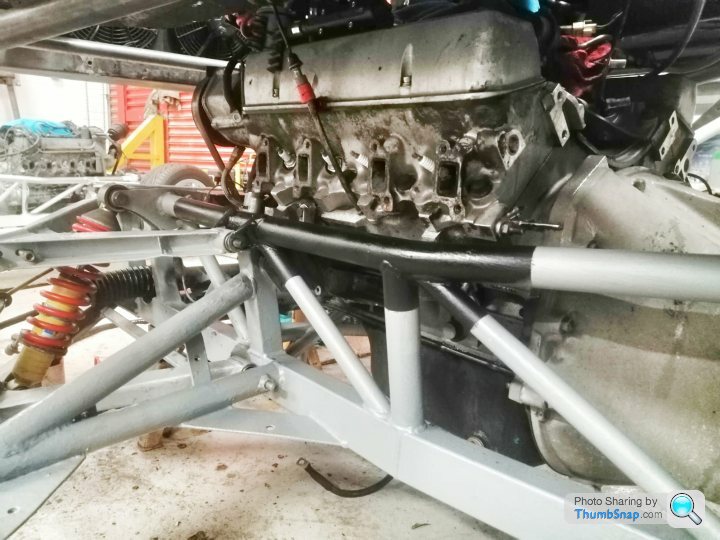
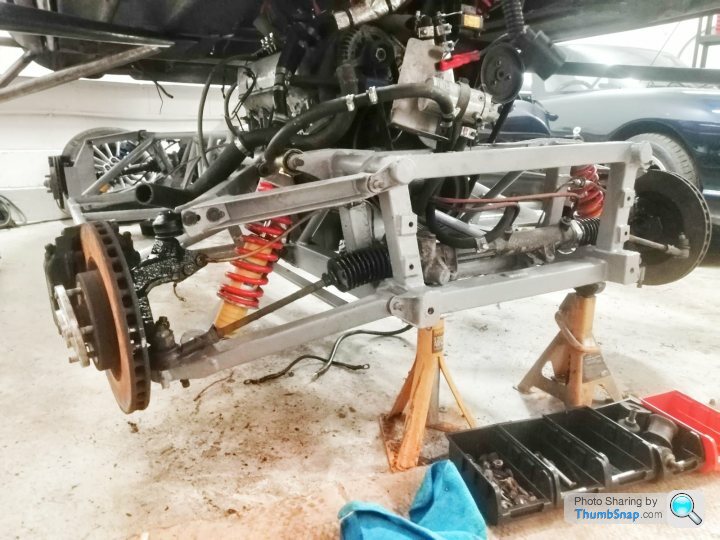
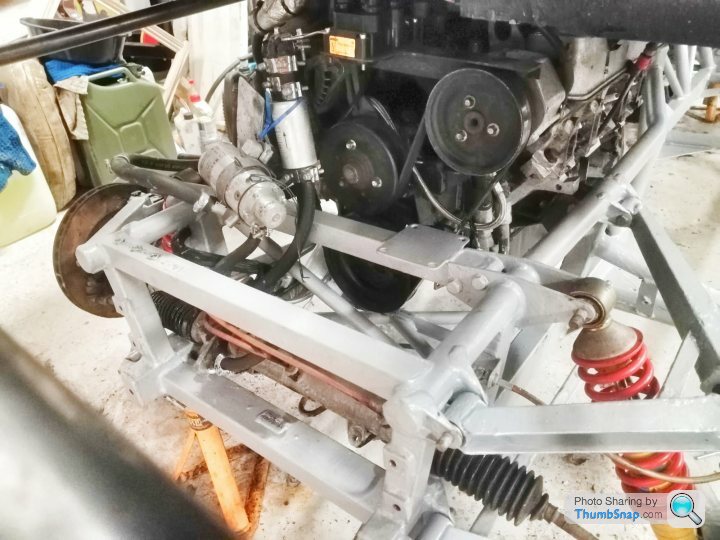

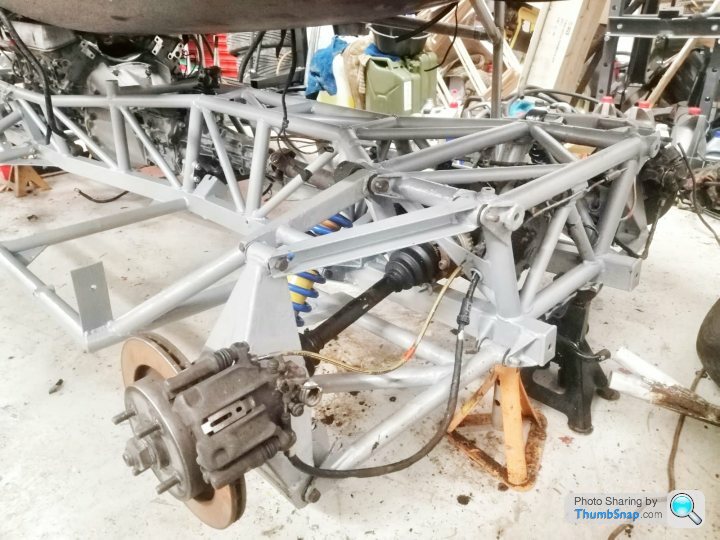

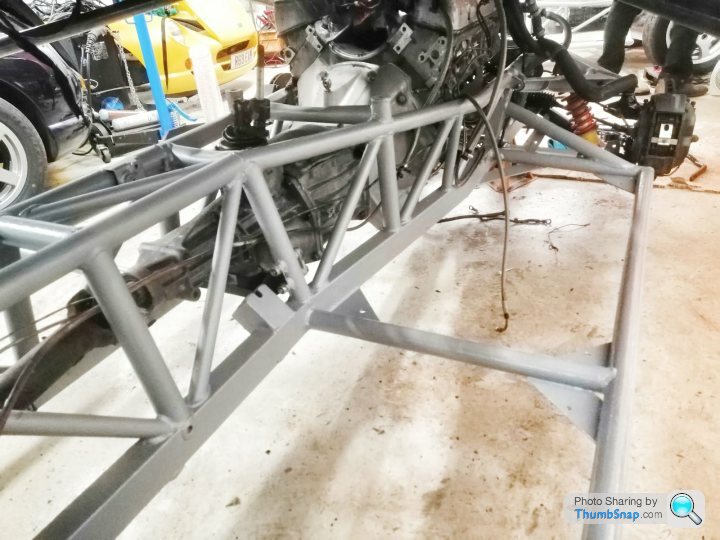
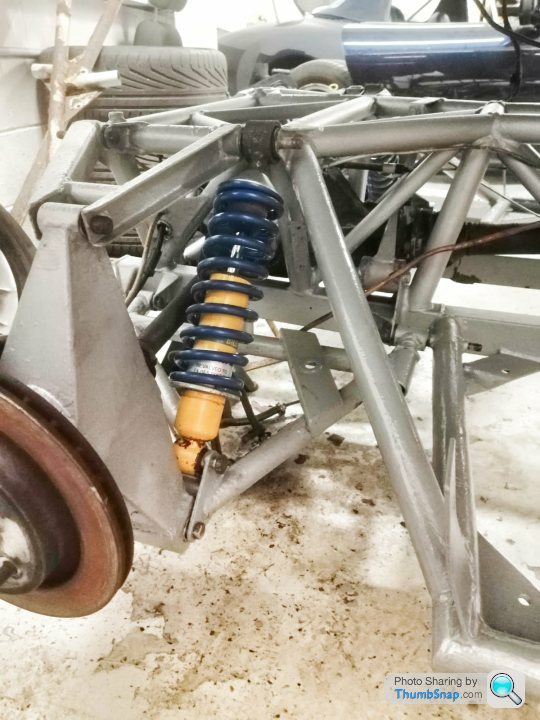
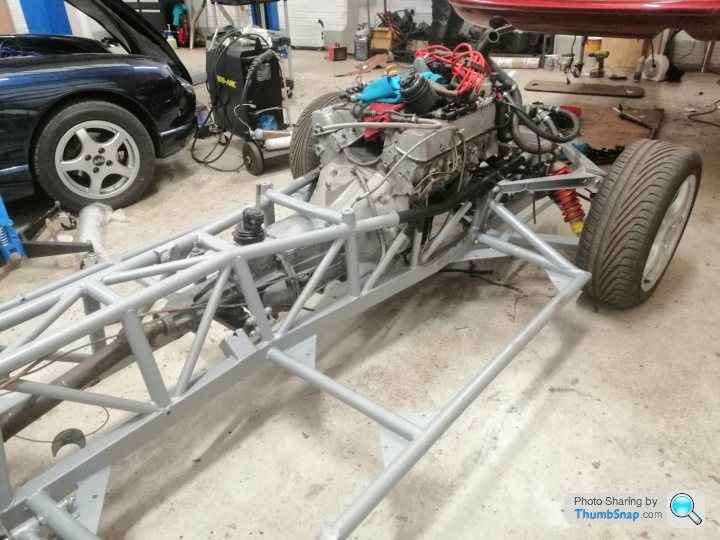
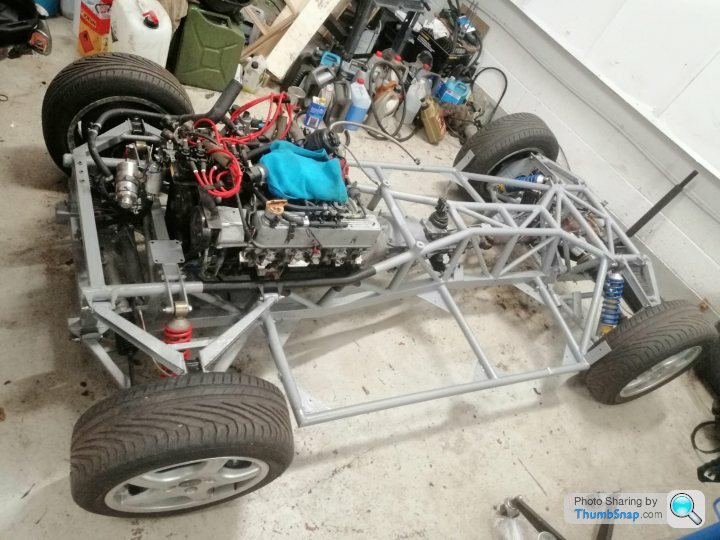
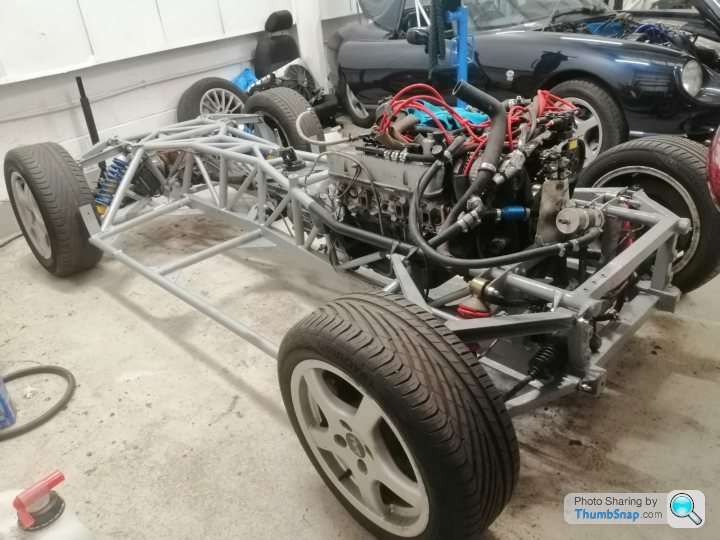
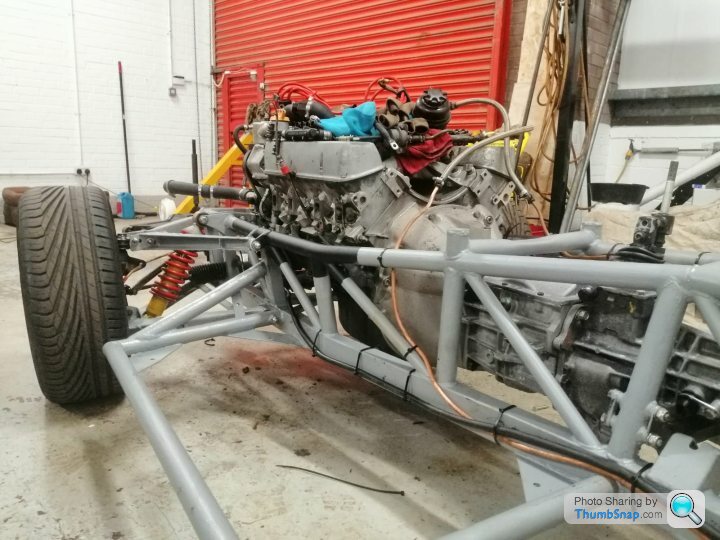

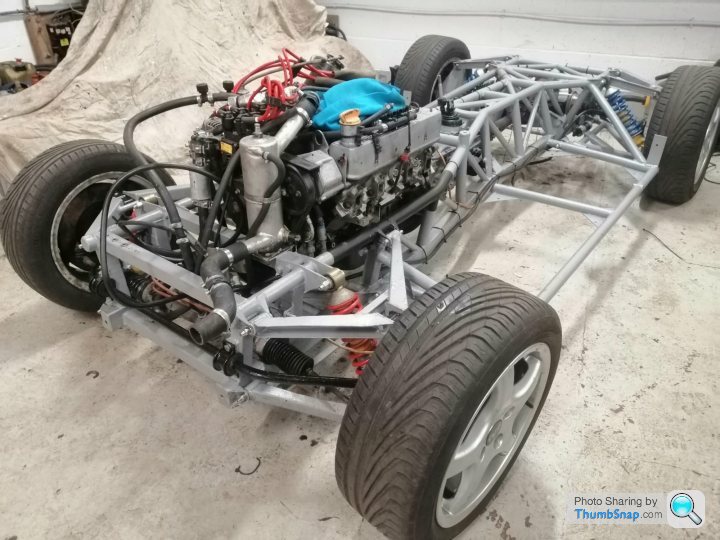
1. It's cheap, because all you need is a shipping container as your booth and basic oven, and a few hundred quids worth of kit, check out the cost of setting up a professional paint booth and compare it with powder coating set up costs and you'll soon see why it's so popular
2. It gives a lovely smooth finish that makes for some fantastic looking results, especially in our favorite PH chassis restoration posts
3. Unlike a wet paint system the operator doesn't need any special skills to apply it, very professional looking results can be achieved by someone with very little to no training, and in what in the world of proper wet painting would be considered an extremely dirty environment
But for all it's advantages, which are really only advantages for powder coater BTW, the key failing of powder coat is that it doesn't actually bond with the substrate on a molecular level like a properly applied wet paint system will, don't get me wrong some powder coat jobs are incredibly tough but they are completely reliant on this primary film strength. Once chipped, and even the best powder coat job will chip, the writing is on the wall because water will enter under the skin where it'll be trapped, it'll also start to creep as the powder coat begins to lift.
Corrosion of the steel substrate beneath is inevitable, the powder coat will continue to lift because it's not a coating that's chemically bonded to what it's covering (the substrate), powder coat is essentially a heat cured wrap applied electrostatically in powder form, you could galvanize the substrate before powder coating but all you're doing here is solving the weakness of powder coat, ie it's propensity to chip, I'd argue a better approach would be to use a superior coating system in the first place.
It's also worth understanding how galvanizing works, using the anode & cathode principle of dissimilar metals galvanizing is a sacrificial system, ie the zinc or aluminum used will corrode before the steel substrate it's coating. Corrosion is corrosion, do you really want zinc or aluminum oxide forming on your steel chassis under your coating system? If you've galvanized then powder coated a steel chassis when the powder coat chips the galv will start to do it's thing, aluminum or znic oxide will form lifting the powder coat, in this respect its no different to iron oxide.
Galvanizing is a fantastic proven anti-corrosion process that's been used to great effect for 150 years or more, you see it everywhere from Armco crash barriers on the motorway to steel wheel barrows and everything in between. But take note, the theme is nearly always the same, surfaces that get galvanized are not typically painted or powder coated. Don't get me wrong it does go on but the vast majority of galvanized items and structures are just left bare, and they are left bare on purpose to allow the zinc to do it's sacrificial corroding thing.
When choosing your chassis coating system it makes sense to study what products are used in marine industries where extreme saline and impact damage conditions are expected, look at what's used on ship hulls, ferry loading decks where high traffic is expected, and oil rigs. In all cases you'll find two component epoxy based wet paint systems are the coatings of choice, so if you really want your TVR chassis to last it makes sense to follow what the marine and oil industries have been using for years.
The market leaders in marine coatings are International and Jotun, both offer a range of two component epoxy based paint systems that are ideal to protect your TVR chassis for decades. As with powder coat resistance against impact damage is key, however a good epoxy based wet paint system will have self healing qualities powder coat simply can't offer. Better still the development of these paint systems has seen the introduction of plastisers that give flexibility to the coating which massively improves its abrasion and impact resistance.
In summary what you're looking for is an industrial two component epoxy mastic wet paint system, I chose Jotamastic 90 which is the latest and best performing system from Norwegian market leader Jotun, taking it one step further I went with Jotamastic 90 which carries powdered aluminum locked into the paint, this acts as a sacrificial anode, being locked into the paint system itself when it starts to do its thing it's designed not to affect the performance o durability of the coating.
Obviously the performance and longevity of any coating can be directly linked to the quality of surface preparation, however Jotamastic 90 Aluminum is designed to be very forgiving in this respect as it is intended to be used as a maintenance coating as well as the primary coating on new structures. De-rusting is still key but if this is not possible Jotamastic 90 Aluminum will still give outstanding results, properly mechanically de-rust and even if you've missed a tiny area of iron oxide this paint system will itself see to it so it never becomes a growing problem.
As it turns out Jotamastic 90 Aluminum is also a very close match to the silver/grey chassis coating used by TVR on all Chimaeras and Griffiths up to the end of 1996, this fortunate twist of fate worked in my favor as I have one of the last Chimaeras built with the superior protected silver/grey chassis that is well accepted to last a lot longer than the dreaded while powder coated chassis' that followed. Jotamastic 90 Aluminum can be put onto service within just 48 hours or less depending on the grade of activator used, however the full molecular cure will take a full three months after which there isn't a wet pain system in the world that can tough it for durability, longevity and corrosion resistance.
My chassis and wishbones received two coats of Jotamastic 90 Aluminum and ended up taking some 5 litres of paint in total at a cost of £101.28 all in inculing VAT & delivery.
More on this paint system and the results on the final page here:
https://www.pistonheads.com/gassing/topic.asp?h=0&...


And this is what it looks like on my chassis applied by brush, don't dismiss brush paining either as you can actually achieve a higher film thickness with a brush and this is how Jotun intend for their Jotamastic 90 Aluminum to be applied, it can also be sprayed out but will require additional thinning which can have a slight negative impact on its performance long term so in many respects 'brush is better'















Edited by ChimpOnGas on Tuesday 9th June 09:36
Thanks for all the replies!
Appreciate the link and I'll have a read through. I wonder if there's a powerflex kit that exists for the Chimaera? I certainly don't want to go through the pain of swapping the bushes for standard replacement items without a hydraulic press.
mk1fan said:
Google is your friend. Lots of threads across these TVR forums about chassis refurbs and options.
Striping down to the chassis and rebuilding a TVR isn't that difficult on the 'mechanic' scale but there are some hard bits - wheel bearing bolts for example.
There really is excellent value in searching through the TVR forums, as a whole, on here. Chassis treatments are not model dependent and info isn't always cross posted between the subsets.
I will have a search in the whole TVR forum, I think I was just limited to the Chimaera. Striping down to the chassis and rebuilding a TVR isn't that difficult on the 'mechanic' scale but there are some hard bits - wheel bearing bolts for example.
There really is excellent value in searching through the TVR forums, as a whole, on here. Chassis treatments are not model dependent and info isn't always cross posted between the subsets.
Mark_S_24 said:
Hi,
I'm in Scotland so can't help on Places etc.
If you have enough room you can do most of the work yourself.
This guy got the prep done to remove the body in 4 to 5 hours... I took 18 Days :-)
https://www.youtube.com/watch?v=iX8OLAhvehQ
Once the body is off, it's a case of removing the Engine/Gearbox/Diff/Brakes etc.
Again all doable if you are confident to remove a body.
Here is a link to the Guide I used
https://tvrcarclub.de/wp-content/uploads/2016/12/TVRChimaeraBodyLiftChecklist22Nov09v1.pdf
Then if you've gone that far you can face the pain of taking the bushes out, or that might be the point to palm it off :-)
And of course, as you take things apart expect to pay for new bits... it'll go up & up :-)
Good Luck
Mark
Thanks Mark, funnily enough I was watching that video yesterday morning which inspired me to start this thread! I'm interested to see how he removes the body, I did see two engine cranes in the thumbnail. I'm in Scotland so can't help on Places etc.
If you have enough room you can do most of the work yourself.
This guy got the prep done to remove the body in 4 to 5 hours... I took 18 Days :-)
https://www.youtube.com/watch?v=iX8OLAhvehQ
Once the body is off, it's a case of removing the Engine/Gearbox/Diff/Brakes etc.
Again all doable if you are confident to remove a body.
Here is a link to the Guide I used
https://tvrcarclub.de/wp-content/uploads/2016/12/TVRChimaeraBodyLiftChecklist22Nov09v1.pdf
Then if you've gone that far you can face the pain of taking the bushes out, or that might be the point to palm it off :-)
And of course, as you take things apart expect to pay for new bits... it'll go up & up :-)
Good Luck
Mark
Appreciate the link and I'll have a read through. I wonder if there's a powerflex kit that exists for the Chimaera? I certainly don't want to go through the pain of swapping the bushes for standard replacement items without a hydraulic press.
Belle427 said:
You may as well get it blasted and paint it yourself, some useful stuff in this thread regarding paint.
https://www.pistonheads.com/gassing/topic.asp?h=0&...
Thanks Belle had a read through this last night. My issue is I'm not confident enough with welding to do the outriggers and any other chassis repairs myself, so I thought I may as well ship it to somewhere who can do all that.https://www.pistonheads.com/gassing/topic.asp?h=0&...
magpies said:
There are a couple of very good Chim threads - check out ChimpOnGas https://www.pistonheads.com/gassing/topic.asp?h=0&... and Classic Chim https://www.pistonheads.com/gassing/topic.asp?h=0&...
They are long reads but worth it. I also stripped my TVR S down and rebuilt in early 2000's when I refurbed the chassis, having it blasted then I repaired and painted with Hammerite and then again last year (I changed my engine and 'box to a Jaguar) this gave me a chance to check out the chassis - there was no rust at all so recoated with Hammerite again.
Thanks I will have a read through these. Jaguar engine that's interesting - which engine out of interest? V6 from an X type?They are long reads but worth it. I also stripped my TVR S down and rebuilt in early 2000's when I refurbed the chassis, having it blasted then I repaired and painted with Hammerite and then again last year (I changed my engine and 'box to a Jaguar) this gave me a chance to check out the chassis - there was no rust at all so recoated with Hammerite again.
ChimpOnGas said:
Message
ChimpOnGas thanks so much for that detailed reply. Very useful and appreciate you taking the time to write that out. Your reply makes sense about the different coating systems, I have been offshore in the north sea and it's amazing how well the paint withstands the weather conditions. £101 is very reasonable and I suppose the main purpose of the paint is to protect the chassis, so it doesn't matter too much if it was sprayed or brushed on. I could certainly see myself going down that route - I just need to find someone to weld the chassis now!Belle427 said:
Are you able to get the chassis transported to the guy that Chimpongas used ?
He does some nice work so may be a lot easier to get it back ready to go.
I think this is a very good idea if you want it painted rather than Powder coated. Maybe others like Powers Performance can paint or get it painted on your behalf. He does some nice work so may be a lot easier to get it back ready to go.
I’m sure both could receive your rusty chassis, mark up and replace outriggers at their works and it come back accurate enough to fit body after costing it for you.
In answer to Qbee post
I had my new riggers fabricated and welded in place then eventually an old friend who had welded for a safety cage company came and finished the job. I was lucky enough to know a paint man and we prepared ( which is extensive work ) my chassis and painted it with Epoxy mastic paint as COG above used. A different brand but the same thing basically. I’m very happy with the results even if Covid has caused some serious delays in finishing it. I’m just waiting on some heat shield for the bulkhead as it got missed off my order to arrive and I will be making a concerted effort to finish the car off.
So you can do it yourself and save a lot of money but only if you have lots of time for free.
An idea of what’s easily possible though and the fun pulling it apart and the thrill of re assembly a great Tvr experience. Few cars are so easy and satisfying to do a resto on.

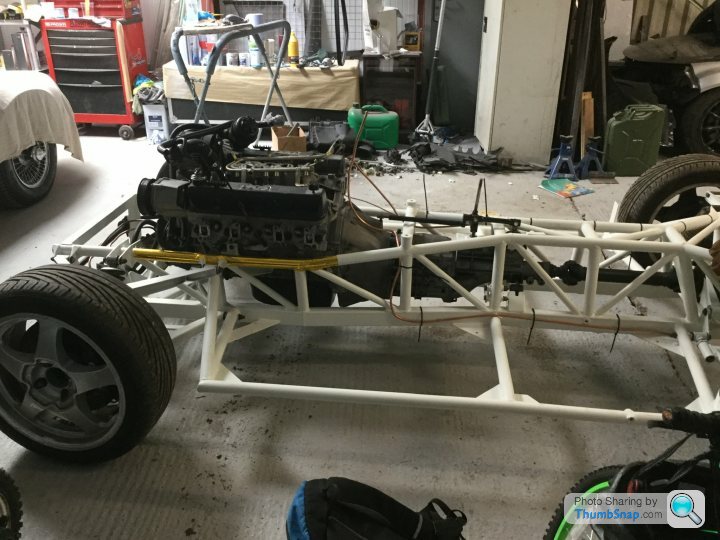
magpies said:
There are a couple of very good Chim threads - check out ChimpOnGas https://www.pistonheads.com/gassing/topic.asp?h=0&... and Classic Chim https://www.pistonheads.com/gassing/topic.asp?h=0&...
They are long reads but worth it. I also stripped my TVR S down and rebuilt in early 2000's when I refurbed the chassis, having it blasted then I repaired and painted with Hammerite and then again last year (I changed my engine and 'box to a Jaguar) this gave me a chance to check out the chassis - there was no rust at all so recoated with Hammerite again.
Thanks I will have a read through these. Jaguar engine that's interesting - which engine out of interest? V6 from an X type?
Hi Shed
It is easier to use the Jaguar S Type engine (and box) as they are designed to drive the rear wheels. You could check out my thread on the TVR S Series page - Cossy sold and Jag bought......... an easy 265bhp too.
There are a couple of very good Chim threads - check out ChimpOnGas https://www.pistonheads.com/gassing/topic.asp?h=0&... and Classic Chim https://www.pistonheads.com/gassing/topic.asp?h=0&...
They are long reads but worth it. I also stripped my TVR S down and rebuilt in early 2000's when I refurbed the chassis, having it blasted then I repaired and painted with Hammerite and then again last year (I changed my engine and 'box to a Jaguar) this gave me a chance to check out the chassis - there was no rust at all so recoated with Hammerite again.
Thanks I will have a read through these. Jaguar engine that's interesting - which engine out of interest? V6 from an X type?
Hi Shed
It is easier to use the Jaguar S Type engine (and box) as they are designed to drive the rear wheels. You could check out my thread on the TVR S Series page - Cossy sold and Jag bought......... an easy 265bhp too.
Hi All,
Bit the bullet a couple of days ago and decided to get this started, whilst also converting the car to Megasquirt engine managment as I've wanted to do for a while. I gave Adrian at RT racing a call who has quoted me a very reasonable price to pick up the bare chassis, repair and paint it, and return it to me. He's even said I can get the wishbones painted at no extra cost!
Almost all the prep to lift the body is done, I just need to remove the fuel tank and disconnect the lines then figure out how on earth I lift it off the car. Considering an engine hoist at the front, then perhaps another engine hoist or a winch onto my garage roof at the back.
Anyone know what grade of bolts I need to replace the original chassis bolts? I would use stainless but I suspect they might be too brittle from my minimal knowledge.
I've enjoyed reading through the threads linked here, lots of useful information and the Jag/Ford powered TVR S was just cool.
Bit the bullet a couple of days ago and decided to get this started, whilst also converting the car to Megasquirt engine managment as I've wanted to do for a while. I gave Adrian at RT racing a call who has quoted me a very reasonable price to pick up the bare chassis, repair and paint it, and return it to me. He's even said I can get the wishbones painted at no extra cost!
Almost all the prep to lift the body is done, I just need to remove the fuel tank and disconnect the lines then figure out how on earth I lift it off the car. Considering an engine hoist at the front, then perhaps another engine hoist or a winch onto my garage roof at the back.
Anyone know what grade of bolts I need to replace the original chassis bolts? I would use stainless but I suspect they might be too brittle from my minimal knowledge.
I've enjoyed reading through the threads linked here, lots of useful information and the Jag/Ford powered TVR S was just cool.
To lift the body off I just used 8 friends & we lifted it by hand & walked it out of the way.
For the bolts I used A4-70 stainless steel, for the chassis they will be fine, I used them almost everywhere however you should not use Stainless for your suspension & drive train, I bought new standard TVR bolts for this as they are high tensile.
For the bolts I used A4-70 stainless steel, for the chassis they will be fine, I used them almost everywhere however you should not use Stainless for your suspension & drive train, I bought new standard TVR bolts for this as they are high tensile.
galvanizing is THE way to do it no corrosion forever)
no corrosion forever)
http://tvr-forum.de/viewtopic.php?f=14&t=6551&...
pics inside
 no corrosion forever)
no corrosion forever)http://tvr-forum.de/viewtopic.php?f=14&t=6551&...
pics inside
I used Jotamastic 90 on my chassis restoration in 2012 and would say so far it’s been very good but not perfect in (that as ChimponGas points out) that chips on the paint due to 2 post lifts or stones etc have pierced the paint protective layer (despite it being very tough) resulting in water creep then creating rust creeping under the paint layer.
Before shipping my car to NZ last year I went over the chassis to prepare and touch up various areas on the out riggers and suspension using a wire wheel, POR 15 and then paint over top to match the green chassis. (NZ customs are very anal about rust on imports should you ever wish to export yours over here.) I found the majority of the chassis to be in excellent condition but it was let down on the corners -the most critical as they are attacked from water, stones and where 2 post lifting points have been placed. Unfortunately the water had gotten under the paint via a chip or scrape and the rust had worked its way along under what looked like paint in good condition. These were a few very small areas but it showed me that it doesn't take much for rust to take hold again so in future I will check and maintain every 1-2 years to ensure durability.
FYI My chassis restoration was done on the smell of an oily rag by a panel beating company local to me. It was a full body off restoration with the chassis and suspension parts being prepared by sand blasting and then repainted with Jotamastic 90. The exception to this was the new pre painted outriggers which were welded onto the chassis after the basting preparation and I suspect that this could be the source of my issue as the paint on the new pre painted outriggers would have likely have been painted over with Jotamastic 90 which is probably not an ideal surface for it to key on to so in hindsight I should have probably had the new outriggers blasted along with the chassis before being painted.
In saying that some suspension areas did have some chips resulting in very minor paint peel back and repair. I also have rubber protectors stopping water dirt and stones from attacking the front outrigger corners.
Over all I’m happy with Jotamastic 90 but I have wondered (should I ever have to do this again in another 20 years??) if a combination of Jotamastic 90 for the main chassis but having just the outriggers galvanised (them being the main area of concern) and then painted over would be the ultimate solution?.
The downside for anyone thinking of hot galvanising their entire chassis is that holes must be drilled in the chassis , and it’s possible the chassis may warp in the process. I had this discussion with a German friend who is intending to dip his chassis and he swears if it’s done properly there will be no issue. Cold spray galvanising is another option but I don’t know much about this process and how effective it is.
Before shipping my car to NZ last year I went over the chassis to prepare and touch up various areas on the out riggers and suspension using a wire wheel, POR 15 and then paint over top to match the green chassis. (NZ customs are very anal about rust on imports should you ever wish to export yours over here.) I found the majority of the chassis to be in excellent condition but it was let down on the corners -the most critical as they are attacked from water, stones and where 2 post lifting points have been placed. Unfortunately the water had gotten under the paint via a chip or scrape and the rust had worked its way along under what looked like paint in good condition. These were a few very small areas but it showed me that it doesn't take much for rust to take hold again so in future I will check and maintain every 1-2 years to ensure durability.
FYI My chassis restoration was done on the smell of an oily rag by a panel beating company local to me. It was a full body off restoration with the chassis and suspension parts being prepared by sand blasting and then repainted with Jotamastic 90. The exception to this was the new pre painted outriggers which were welded onto the chassis after the basting preparation and I suspect that this could be the source of my issue as the paint on the new pre painted outriggers would have likely have been painted over with Jotamastic 90 which is probably not an ideal surface for it to key on to so in hindsight I should have probably had the new outriggers blasted along with the chassis before being painted.
In saying that some suspension areas did have some chips resulting in very minor paint peel back and repair. I also have rubber protectors stopping water dirt and stones from attacking the front outrigger corners.
Over all I’m happy with Jotamastic 90 but I have wondered (should I ever have to do this again in another 20 years??) if a combination of Jotamastic 90 for the main chassis but having just the outriggers galvanised (them being the main area of concern) and then painted over would be the ultimate solution?.
The downside for anyone thinking of hot galvanising their entire chassis is that holes must be drilled in the chassis , and it’s possible the chassis may warp in the process. I had this discussion with a German friend who is intending to dip his chassis and he swears if it’s done properly there will be no issue. Cold spray galvanising is another option but I don’t know much about this process and how effective it is.
Edited by ITVRI on Wednesday 17th June 21:41
This is an absolutely fantastic post, thank you.
I had come to the same conclusion about the epoxy mastic after many years or trying and failing with other products.
I wonder if you have compared the Jotamastic with other products such as Bilt Hamber and rust buster epoxy mastics? Reasoning may suggest the Jotamastic to be a superior product because of its marine origins, but I wondered if you'd looked at the data sheets and ruled them out?
I had come to the same conclusion about the epoxy mastic after many years or trying and failing with other products.
I wonder if you have compared the Jotamastic with other products such as Bilt Hamber and rust buster epoxy mastics? Reasoning may suggest the Jotamastic to be a superior product because of its marine origins, but I wondered if you'd looked at the data sheets and ruled them out?
ChimpOnGas said:
My best advice would be to avoid powder coat, powder coat is popular for the following reasons:
1. It's cheap, because all you need is a shipping container as your booth and basic oven, and a few hundred quids worth of kit, check out the cost of setting up a professional paint booth and compare it with powder coating set up costs and you'll soon see why it's so popular
2. It gives a lovely smooth finish that makes for some fantastic looking results, especially in our favorite PH chassis restoration posts
3. Unlike a wet paint system the operator doesn't need any special skills to apply it, very professional looking results can be achieved by someone with very little to no training, and in what in the world of proper wet painting would be considered an extremely dirty environment
But for all it's advantages, which are really only advantages for powder coater BTW, the key failing of powder coat is that it doesn't actually bond with the substrate on a molecular level like a properly applied wet paint system will, don't get me wrong some powder coat jobs are incredibly tough but they are completely reliant on this primary film strength. Once chipped, and even the best powder coat job will chip, the writing is on the wall because water will enter under the skin where it'll be trapped, it'll also start to creep as the powder coat begins to lift.
Corrosion of the steel substrate beneath is inevitable, the powder coat will continue to lift because it's not a coating that's chemically bonded to what it's covering (the substrate), powder coat is essentially a heat cured wrap applied electrostatically in powder form, you could galvanize the substrate before powder coating but all you're doing here is solving the weakness of powder coat, ie it's propensity to chip, I'd argue a better approach would be to use a superior coating system in the first place.
It's also worth understanding how galvanizing works, using the anode & cathode principle of dissimilar metals galvanizing is a sacrificial system, ie the zinc or aluminum used will corrode before the steel substrate it's coating. Corrosion is corrosion, do you really want zinc or aluminum oxide forming on your steel chassis under your coating system? If you've galvanized then powder coated a steel chassis when the powder coat chips the galv will start to do it's thing, aluminum or znic oxide will form lifting the powder coat, in this respect its no different to iron oxide.
Galvanizing is a fantastic proven anti-corrosion process that's been used to great effect for 150 years or more, you see it everywhere from Armco crash barriers on the motorway to steel wheel barrows and everything in between. But take note, the theme is nearly always the same, surfaces that get galvanized are not typically painted or powder coated. Don't get me wrong it does go on but the vast majority of galvanized items and structures are just left bare, and they are left bare on purpose to allow the zinc to do it's sacrificial corroding thing.
When choosing your chassis coating system it makes sense to study what products are used in marine industries where extreme saline and impact damage conditions are expected, look at what's used on ship hulls, ferry loading decks where high traffic is expected, and oil rigs. In all cases you'll find two component epoxy based wet paint systems are the coatings of choice, so if you really want your TVR chassis to last it makes sense to follow what the marine and oil industries have been using for years.
The market leaders in marine coatings are International and Jotun, both offer a range of two component epoxy based paint systems that are ideal to protect your TVR chassis for decades. As with powder coat resistance against impact damage is key, however a good epoxy based wet paint system will have self healing qualities powder coat simply can't offer. Better still the development of these paint systems has seen the introduction of plastisers that give flexibility to the coating which massively improves its abrasion and impact resistance.
In summary what you're looking for is an industrial two component epoxy mastic wet paint system, I chose Jotamastic 90 which is the latest and best performing system from Norwegian market leader Jotun, taking it one step further I went with Jotamastic 90 which carries powdered aluminum locked into the paint, this acts as a sacrificial anode, being locked into the paint system itself when it starts to do its thing it's designed not to affect the performance o durability of the coating.
Obviously the performance and longevity of any coating can be directly linked to the quality of surface preparation, however Jotamastic 90 Aluminum is designed to be very forgiving in this respect as it is intended to be used as a maintenance coating as well as the primary coating on new structures. De-rusting is still key but if this is not possible Jotamastic 90 Aluminum will still give outstanding results, properly mechanically de-rust and even if you've missed a tiny area of iron oxide this paint system will itself see to it so it never becomes a growing problem.
As it turns out Jotamastic 90 Aluminum is also a very close match to the silver/grey chassis coating used by TVR on all Chimaeras and Griffiths up to the end of 1996, this fortunate twist of fate worked in my favor as I have one of the last Chimaeras built with the superior protected silver/grey chassis that is well accepted to last a lot longer than the dreaded while powder coated chassis' that followed. Jotamastic 90 Aluminum can be put onto service within just 48 hours or less depending on the grade of activator used, however the full molecular cure will take a full three months after which there isn't a wet pain system in the world that can tough it for durability, longevity and corrosion resistance.
My chassis and wishbones received two coats of Jotamastic 90 Aluminum and ended up taking some 5 litres of paint in total at a cost of £101.28 all in inculing VAT & delivery.
1. It's cheap, because all you need is a shipping container as your booth and basic oven, and a few hundred quids worth of kit, check out the cost of setting up a professional paint booth and compare it with powder coating set up costs and you'll soon see why it's so popular
2. It gives a lovely smooth finish that makes for some fantastic looking results, especially in our favorite PH chassis restoration posts
3. Unlike a wet paint system the operator doesn't need any special skills to apply it, very professional looking results can be achieved by someone with very little to no training, and in what in the world of proper wet painting would be considered an extremely dirty environment
But for all it's advantages, which are really only advantages for powder coater BTW, the key failing of powder coat is that it doesn't actually bond with the substrate on a molecular level like a properly applied wet paint system will, don't get me wrong some powder coat jobs are incredibly tough but they are completely reliant on this primary film strength. Once chipped, and even the best powder coat job will chip, the writing is on the wall because water will enter under the skin where it'll be trapped, it'll also start to creep as the powder coat begins to lift.
Corrosion of the steel substrate beneath is inevitable, the powder coat will continue to lift because it's not a coating that's chemically bonded to what it's covering (the substrate), powder coat is essentially a heat cured wrap applied electrostatically in powder form, you could galvanize the substrate before powder coating but all you're doing here is solving the weakness of powder coat, ie it's propensity to chip, I'd argue a better approach would be to use a superior coating system in the first place.
It's also worth understanding how galvanizing works, using the anode & cathode principle of dissimilar metals galvanizing is a sacrificial system, ie the zinc or aluminum used will corrode before the steel substrate it's coating. Corrosion is corrosion, do you really want zinc or aluminum oxide forming on your steel chassis under your coating system? If you've galvanized then powder coated a steel chassis when the powder coat chips the galv will start to do it's thing, aluminum or znic oxide will form lifting the powder coat, in this respect its no different to iron oxide.
Galvanizing is a fantastic proven anti-corrosion process that's been used to great effect for 150 years or more, you see it everywhere from Armco crash barriers on the motorway to steel wheel barrows and everything in between. But take note, the theme is nearly always the same, surfaces that get galvanized are not typically painted or powder coated. Don't get me wrong it does go on but the vast majority of galvanized items and structures are just left bare, and they are left bare on purpose to allow the zinc to do it's sacrificial corroding thing.
When choosing your chassis coating system it makes sense to study what products are used in marine industries where extreme saline and impact damage conditions are expected, look at what's used on ship hulls, ferry loading decks where high traffic is expected, and oil rigs. In all cases you'll find two component epoxy based wet paint systems are the coatings of choice, so if you really want your TVR chassis to last it makes sense to follow what the marine and oil industries have been using for years.
The market leaders in marine coatings are International and Jotun, both offer a range of two component epoxy based paint systems that are ideal to protect your TVR chassis for decades. As with powder coat resistance against impact damage is key, however a good epoxy based wet paint system will have self healing qualities powder coat simply can't offer. Better still the development of these paint systems has seen the introduction of plastisers that give flexibility to the coating which massively improves its abrasion and impact resistance.
In summary what you're looking for is an industrial two component epoxy mastic wet paint system, I chose Jotamastic 90 which is the latest and best performing system from Norwegian market leader Jotun, taking it one step further I went with Jotamastic 90 which carries powdered aluminum locked into the paint, this acts as a sacrificial anode, being locked into the paint system itself when it starts to do its thing it's designed not to affect the performance o durability of the coating.
Obviously the performance and longevity of any coating can be directly linked to the quality of surface preparation, however Jotamastic 90 Aluminum is designed to be very forgiving in this respect as it is intended to be used as a maintenance coating as well as the primary coating on new structures. De-rusting is still key but if this is not possible Jotamastic 90 Aluminum will still give outstanding results, properly mechanically de-rust and even if you've missed a tiny area of iron oxide this paint system will itself see to it so it never becomes a growing problem.
As it turns out Jotamastic 90 Aluminum is also a very close match to the silver/grey chassis coating used by TVR on all Chimaeras and Griffiths up to the end of 1996, this fortunate twist of fate worked in my favor as I have one of the last Chimaeras built with the superior protected silver/grey chassis that is well accepted to last a lot longer than the dreaded while powder coated chassis' that followed. Jotamastic 90 Aluminum can be put onto service within just 48 hours or less depending on the grade of activator used, however the full molecular cure will take a full three months after which there isn't a wet pain system in the world that can tough it for durability, longevity and corrosion resistance.
My chassis and wishbones received two coats of Jotamastic 90 Aluminum and ended up taking some 5 litres of paint in total at a cost of £101.28 all in inculing VAT & delivery.
Edited by ChimpOnGas on Tuesday 9th June 09:36
Neil_Sc said:
This is an absolutely fantastic post, thank you.
I had come to the same conclusion about the epoxy mastic after many years or trying and failing with other products.
I wonder if you have compared the Jotamastic with other products such as Bilt Hamber and rust buster epoxy mastics? Reasoning may suggest the Jotamastic to be a superior product because of its marine origins, but I wondered if you'd looked at the data sheets and ruled them out?
BalanceI had come to the same conclusion about the epoxy mastic after many years or trying and failing with other products.
I wonder if you have compared the Jotamastic with other products such as Bilt Hamber and rust buster epoxy mastics? Reasoning may suggest the Jotamastic to be a superior product because of its marine origins, but I wondered if you'd looked at the data sheets and ruled them out?
ChimpOnGas said:
My best advice would be to avoid powder coat, powder coat is popular for the following reasons:
1. It's cheap, because all you need is a shipping container as your booth and basic oven, and a few hundred quids worth of kit, check out the cost of setting up a professional paint booth and compare it with powder coating set up costs and you'll soon see why it's so popular
2. It gives a lovely smooth finish that makes for some fantastic looking results, especially in our favorite PH chassis restoration posts
3. Unlike a wet paint system the operator doesn't need any special skills to apply it, very professional looking results can be achieved by someone with very little to no training, and in what in the world of proper wet painting would be considered an extremely dirty environment
But for all it's advantages, which are really only advantages for powder coater BTW, the key failing of powder coat is that it doesn't actually bond with the substrate on a molecular level like a properly applied wet paint system will, don't get me wrong some powder coat jobs are incredibly tough but they are completely reliant on this primary film strength. Once chipped, and even the best powder coat job will chip, the writing is on the wall because water will enter under the skin where it'll be trapped, it'll also start to creep as the powder coat begins to lift.
Corrosion of the steel substrate beneath is inevitable, the powder coat will continue to lift because it's not a coating that's chemically bonded to what it's covering (the substrate), powder coat is essentially a heat cured wrap applied electrostatically in powder form, you could galvanize the substrate before powder coating but all you're doing here is solving the weakness of powder coat, ie it's propensity to chip, I'd argue a better approach would be to use a superior coating system in the first place.
It's also worth understanding how galvanizing works, using the anode & cathode principle of dissimilar metals galvanizing is a sacrificial system, ie the zinc or aluminum used will corrode before the steel substrate it's coating. Corrosion is corrosion, do you really want zinc or aluminum oxide forming on your steel chassis under your coating system? If you've galvanized then powder coated a steel chassis when the powder coat chips the galv will start to do it's thing, aluminum or znic oxide will form lifting the powder coat, in this respect its no different to iron oxide.
Galvanizing is a fantastic proven anti-corrosion process that's been used to great effect for 150 years or more, you see it everywhere from Armco crash barriers on the motorway to steel wheel barrows and everything in between. But take note, the theme is nearly always the same, surfaces that get galvanized are not typically painted or powder coated. Don't get me wrong it does go on but the vast majority of galvanized items and structures are just left bare, and they are left bare on purpose to allow the zinc to do it's sacrificial corroding thing.
When choosing your chassis coating system it makes sense to study what products are used in marine industries where extreme saline and impact damage conditions are expected, look at what's used on ship hulls, ferry loading decks where high traffic is expected, and oil rigs. In all cases you'll find two component epoxy based wet paint systems are the coatings of choice, so if you really want your TVR chassis to last it makes sense to follow what the marine and oil industries have been using for years.
The market leaders in marine coatings are International and Jotun, both offer a range of two component epoxy based paint systems that are ideal to protect your TVR chassis for decades. As with powder coat resistance against impact damage is key, however a good epoxy based wet paint system will have self healing qualities powder coat simply can't offer. Better still the development of these paint systems has seen the introduction of plastisers that give flexibility to the coating which massively improves its abrasion and impact resistance.
In summary what you're looking for is an industrial two component epoxy mastic wet paint system, I chose Jotamastic 90 which is the latest and best performing system from Norwegian market leader Jotun, taking it one step further I went with Jotamastic 90 which carries powdered aluminum locked into the paint, this acts as a sacrificial anode, being locked into the paint system itself when it starts to do its thing it's designed not to affect the performance o durability of the coating.
Obviously the performance and longevity of any coating can be directly linked to the quality of surface preparation, however Jotamastic 90 Aluminum is designed to be very forgiving in this respect as it is intended to be used as a maintenance coating as well as the primary coating on new structures. De-rusting is still key but if this is not possible Jotamastic 90 Aluminum will still give outstanding results, properly mechanically de-rust and even if you've missed a tiny area of iron oxide this paint system will itself see to it so it never becomes a growing problem.
As it turns out Jotamastic 90 Aluminum is also a very close match to the silver/grey chassis coating used by TVR on all Chimaeras and Griffiths up to the end of 1996, this fortunate twist of fate worked in my favor as I have one of the last Chimaeras built with the superior protected silver/grey chassis that is well accepted to last a lot longer than the dreaded while powder coated chassis' that followed. Jotamastic 90 Aluminum can be put onto service within just 48 hours or less depending on the grade of activator used, however the full molecular cure will take a full three months after which there isn't a wet pain system in the world that can tough it for durability, longevity and corrosion resistance.
My chassis and wishbones received two coats of Jotamastic 90 Aluminum and ended up taking some 5 litres of paint in total at a cost of £101.28 all in inculing VAT & delivery.
1. It's cheap, because all you need is a shipping container as your booth and basic oven, and a few hundred quids worth of kit, check out the cost of setting up a professional paint booth and compare it with powder coating set up costs and you'll soon see why it's so popular
2. It gives a lovely smooth finish that makes for some fantastic looking results, especially in our favorite PH chassis restoration posts
3. Unlike a wet paint system the operator doesn't need any special skills to apply it, very professional looking results can be achieved by someone with very little to no training, and in what in the world of proper wet painting would be considered an extremely dirty environment
But for all it's advantages, which are really only advantages for powder coater BTW, the key failing of powder coat is that it doesn't actually bond with the substrate on a molecular level like a properly applied wet paint system will, don't get me wrong some powder coat jobs are incredibly tough but they are completely reliant on this primary film strength. Once chipped, and even the best powder coat job will chip, the writing is on the wall because water will enter under the skin where it'll be trapped, it'll also start to creep as the powder coat begins to lift.
Corrosion of the steel substrate beneath is inevitable, the powder coat will continue to lift because it's not a coating that's chemically bonded to what it's covering (the substrate), powder coat is essentially a heat cured wrap applied electrostatically in powder form, you could galvanize the substrate before powder coating but all you're doing here is solving the weakness of powder coat, ie it's propensity to chip, I'd argue a better approach would be to use a superior coating system in the first place.
It's also worth understanding how galvanizing works, using the anode & cathode principle of dissimilar metals galvanizing is a sacrificial system, ie the zinc or aluminum used will corrode before the steel substrate it's coating. Corrosion is corrosion, do you really want zinc or aluminum oxide forming on your steel chassis under your coating system? If you've galvanized then powder coated a steel chassis when the powder coat chips the galv will start to do it's thing, aluminum or znic oxide will form lifting the powder coat, in this respect its no different to iron oxide.
Galvanizing is a fantastic proven anti-corrosion process that's been used to great effect for 150 years or more, you see it everywhere from Armco crash barriers on the motorway to steel wheel barrows and everything in between. But take note, the theme is nearly always the same, surfaces that get galvanized are not typically painted or powder coated. Don't get me wrong it does go on but the vast majority of galvanized items and structures are just left bare, and they are left bare on purpose to allow the zinc to do it's sacrificial corroding thing.
When choosing your chassis coating system it makes sense to study what products are used in marine industries where extreme saline and impact damage conditions are expected, look at what's used on ship hulls, ferry loading decks where high traffic is expected, and oil rigs. In all cases you'll find two component epoxy based wet paint systems are the coatings of choice, so if you really want your TVR chassis to last it makes sense to follow what the marine and oil industries have been using for years.
The market leaders in marine coatings are International and Jotun, both offer a range of two component epoxy based paint systems that are ideal to protect your TVR chassis for decades. As with powder coat resistance against impact damage is key, however a good epoxy based wet paint system will have self healing qualities powder coat simply can't offer. Better still the development of these paint systems has seen the introduction of plastisers that give flexibility to the coating which massively improves its abrasion and impact resistance.
In summary what you're looking for is an industrial two component epoxy mastic wet paint system, I chose Jotamastic 90 which is the latest and best performing system from Norwegian market leader Jotun, taking it one step further I went with Jotamastic 90 which carries powdered aluminum locked into the paint, this acts as a sacrificial anode, being locked into the paint system itself when it starts to do its thing it's designed not to affect the performance o durability of the coating.
Obviously the performance and longevity of any coating can be directly linked to the quality of surface preparation, however Jotamastic 90 Aluminum is designed to be very forgiving in this respect as it is intended to be used as a maintenance coating as well as the primary coating on new structures. De-rusting is still key but if this is not possible Jotamastic 90 Aluminum will still give outstanding results, properly mechanically de-rust and even if you've missed a tiny area of iron oxide this paint system will itself see to it so it never becomes a growing problem.
As it turns out Jotamastic 90 Aluminum is also a very close match to the silver/grey chassis coating used by TVR on all Chimaeras and Griffiths up to the end of 1996, this fortunate twist of fate worked in my favor as I have one of the last Chimaeras built with the superior protected silver/grey chassis that is well accepted to last a lot longer than the dreaded while powder coated chassis' that followed. Jotamastic 90 Aluminum can be put onto service within just 48 hours or less depending on the grade of activator used, however the full molecular cure will take a full three months after which there isn't a wet pain system in the world that can tough it for durability, longevity and corrosion resistance.
My chassis and wishbones received two coats of Jotamastic 90 Aluminum and ended up taking some 5 litres of paint in total at a cost of £101.28 all in inculing VAT & delivery.
Edited by ChimpOnGas on Tuesday 9th June 09:36
Any coating can be applied badly and by untrained personnel - its not the preserve of Powder coat. Powder coat done well is excellent and durable.
(after using it for 30 years, and not applied by folk that primarily do garden furniture, I've had no issues).
Would I brush paint, personally, no.
Min and Max DFT is important to a paint system, something difficult to control with brush application. Humidity and temperature control is almost none existent at home. Do you blast to SA 2.5 or close before coating?
No criticism of the range of Jotamastic products. Generally first class but without the controls, not sure how good it is..

A tip when building the chassis back up - try to isolate the copper pipework from the chassis coating by sleeving. Plastic tube or similar?
Edited by anonymous-user on Thursday 18th June 10:17
TVRMs said:
Balance
Any coating can be applied badly and by untrained personnel - its not the preserve of Powder coat. Powder coat done well is excellent and durable.
(after using it for 30 years, and not applied by folk that primarily do garden furniture, I've had no issues).
Would I brush paint, personally, no.
Min and Max DFT is important to a paint system, something difficult to control with brush application. Humidity and temperature control is almost none existent at home. Do you blast to SA 2.5 or close before coating?
No criticism of the range of Jotamastic products. Generally first class but without the controls, not sure how good it is..
A tip when building the chassis back up - try to isolate the copper pipework from the chassis coating by sleeving. Plastic tube or similar?
Fair points, it's just the low setup cost to become a powder coating business compared with setting up a proper paint shop can attract a different level of professional, and I use the term professional loosely.Any coating can be applied badly and by untrained personnel - its not the preserve of Powder coat. Powder coat done well is excellent and durable.
(after using it for 30 years, and not applied by folk that primarily do garden furniture, I've had no issues).
Would I brush paint, personally, no.
Min and Max DFT is important to a paint system, something difficult to control with brush application. Humidity and temperature control is almost none existent at home. Do you blast to SA 2.5 or close before coating?
No criticism of the range of Jotamastic products. Generally first class but without the controls, not sure how good it is..

A tip when building the chassis back up - try to isolate the copper pipework from the chassis coating by sleeving. Plastic tube or similar?
Edited by TVRMs on Thursday 18th June 10:17
My final point would be nearly all the industrial marine grade epoxy mastic paints are specifically designed for brush application, they're formulated to be applied in some pretty challenging environments to be used in ongoing maintenance of existing steel structures and vessels that do service in extreme saline heavy marine conditions.
I'm sure there are good powder coaters out there that are capable of good results, its just in all my years I've not come across a powder coat job that compares favorably with a good epoxy based two component wet paint finish. Saying that as with any top coat system be it powder or paint, the devil definitely lives in the prep, neglect substrate prep and it doesn't matter what system you use its performance and longevity will be very poor indeed.
My chassis has only just been painted in Jotamastic 90 Aluminum, I have every confidence in the paint system as it's been proven time and time again where it's performance has been intensively tested over many years in industrial marine environments, but only time will tell if the prep work was up to snuff?
TVRMs said:
Dave
It will be interesting to see how your coating stands up as it appears the coating is not intended for brush application?
That would be a worry to me, but for the fact you're talking out the back of your head, I don't know where you're getting your information from but quite simply you are wrong.It will be interesting to see how your coating stands up as it appears the coating is not intended for brush application?
I'm not sure what point you're trying to make but unsupported misinformation seems like competitive point scoring to me, sadly your lack of research has left you exposed to embarrassment but I'll let the paint manufacturer themselves take care of that....
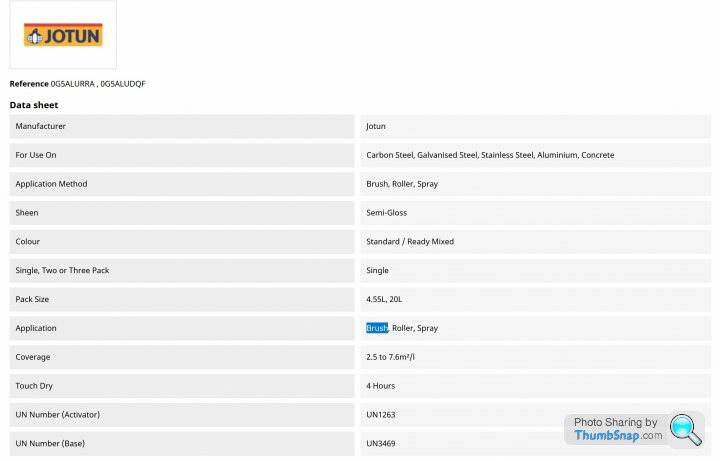
According to Jotun, and one assumes they should know as they make the paint, their Jotamastic 90 product is designed to be applied from anything between 100 to 300 microns in a single coat, as clearly shown above the application can be by brush, roller or spray equipment.
To be clear 100 to 300 microns is a huge range of film thickness, a paint with 60% volume solids applied by brush will typically have a wet thickness of 100 microns, admittedly Jotamastic 90 is a little thicker at 80% solids by volume so you end up with a wet thickness of 133 microns, but quite clearly this is still massively within the manufacturer's own spec being well below the 300 micron maximum film thickness they quote.
Finally if Jotamastic really wasn't meant to be applied by brush, why on earth would they include an image of a guy brush painting the stuff in their Jotamastic catalogue

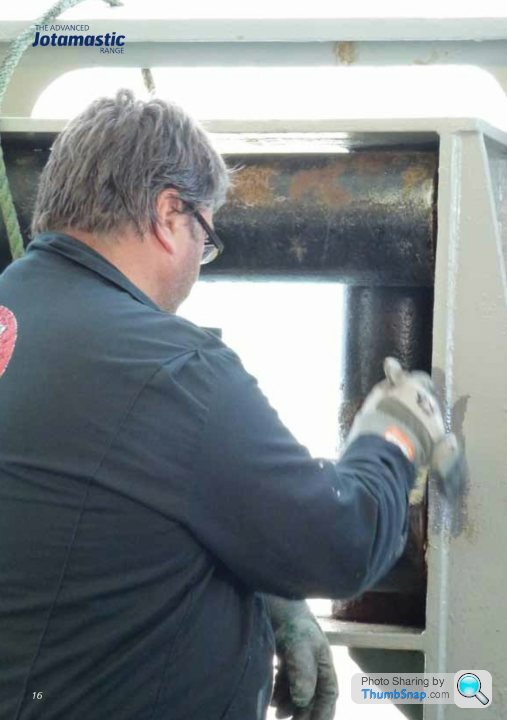
Gassing Station | Chimaera | Top of Page | What's New | My Stuff





